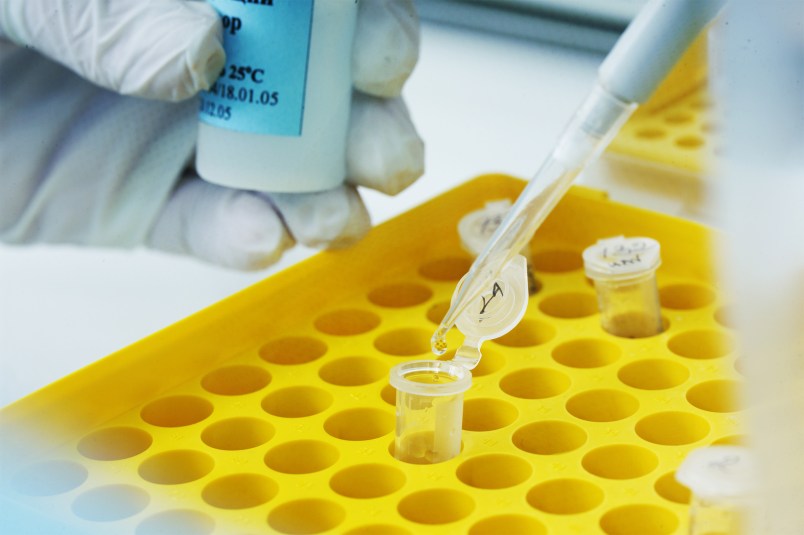It’s hard to imagine a time in the United States when viral diseases like smallpox were commonplace and deadly. In 1900, a smallpox epidemic swept through the nation, killing 894 people and infecting more than 21,000. Thanks to groundbreaking medical advancements over the past century, smallpox and other diseases like it have been wiped out and largely forgotten.
Now, pharmaceutical researchers are working to eradicate contemporary life-threatening conditions like hepatitis C (HCV), a viral infection spread through the blood that affects an estimated 3.2 million Americans. HCV can cause serious long-term health issues including liver damage, liver failure and cancer. Each year, an estimated 12,000 Americans die from HCV, causing more deaths than HIV. Hepatitis C patients miss more work days than other employees, as they have to take sick leave and disability to deal with their illness.
Many patients are asymptomatic and unaware of their infection for years until very serious and expensive complications emerge. For every 100 people infected with HCV, between 60 and 70 will eventually develop chronic liver disease and between one and five will die. Patients have to bear the burden of costly doctor visits, hospital stays, and possibly even a liver transplant, which typically cost as much as $500,000 and require years of costly follow up care. Obtaining a liver transplant is an extremely trying experience, as the number of available organs is limited. Each year, as many as one in ten patients will die while on the liver transplant wait list.
The heavy weight of this disease also falls onto the American healthcare system. The estimated cost for a patient with HCV is $24,176 per year, and as high as $112,537 for those with liver cancer. Furthermore, in the absence of a cure for the disease the cost of overall annual HCV medical spending for patients is expected to more than double from $30 billion to over $85 over the next 20 years. In ten years, Medicare and commercial insurance medical costs associated with hepatitis C are also expected to double, and in 20 years, they are expected to increase fivefold. Medicare specifically will feel the effects of a growing portion of patients with HCV in the program, increasing from 12 percent in 2009 to 39 percent in 2028.
Experts acknowledge the urgency presented by the severity of the disease. “We have a very narrow window of time to find as many people as possible and to cure them as quickly as possible if we want to make a substantial impact on their disease progression as well as on those very expensive complications in the future” says Dr. Camilla Graham of Beth Israel Deaconess Medical Center in Boston.
However, a wave of novel, game-changing hepatitis C medicines have recently been approved or are in development, providing an effective cure for 90 percent of all patients. These new medicines are effective in treating multiple kinds of HCV orally. They also provide reprieve for those who cannot tolerate the harsh side effects of other available medications. Until recently, available therapies only cured about half of all patients and caused debilitating flu-like symptoms. This incredible innovation provides better results in 12 weeks or less, compared to 48 weeks for other medications. Now, patients will be able to lessen the protracted physical, emotional and financial strain of a lifetime of intensive hospital stays and doctors’ visits.

These innovative new medicines have found their way to hepatitis C patients despite staggering odds. It takes ten to 15 years and costs more than $1.2 billion to develop one new drug. Very few drugs make it to the clinical trial phase, and of those that do, only one in six ever have a chance of being approved by the FDA.
Following the immense financial resources and time that go into creating new medicines, the medicine lifecycle of innovation not only brings low-cost generics but also long-term savings to the health system. For example, in the 1980s, many claimed HIV/AIDS would bankrupt the health system. But that didn’t happen. Instead, innovative therapies and the generic medicines which followed have helped keep costs down, halting disease progression and preventing the need for hospitalizations and other costly acute care. Today, due to the emergence of effective treatment options, the death rate has dropped by more than 80 percent and HIV/AIDS has been transformed into a manageable, chronic disease.
In fact even as innovative medicines have emerged, the cost of medicines overall has grown more slowly than other health care costs in recent years and currently make up just 10 to 12 percent of total health care spending.
Just a handful of years ago, a hepatitis C diagnosis used to mean a diminished, compromised life, and it frequently meant death. Now, because of innovative treatment options, hepatitis—like smallpox—is hopefully on its way to becoming a disease of the past.
Sources:
http://www.cdc.gov/mmwr/preview/mmwrhtml/00056803.htm
http://www.cdc.gov/hepatitis/hcv/pdfs/hepcgeneralfactsheet.pdf
http://www.fda.gov/newsevents/newsroom/pressannouncements/ucm377888.htm









